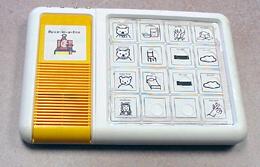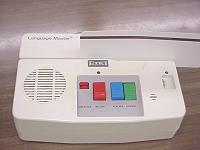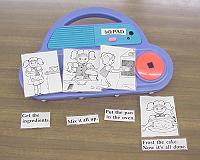Assistive Technology for Students with Autism Spectrum Disorders
“Mid” Technology
Battery operated devices or “simple” electronic devices requiring limited advancements in technology. Example: tape recorder, Language Master, overhead projector, timers, calculators, and simple voice output devices.
-
Language Comprehension Skills
-
Espressive Communication Skills
-
Social Skills
-
Attending Skills (motivation):
-
Organization Skills (story sequencing and time management)
-
Academics
Listed below are descriptions of several “mid” tech devices that can be used by children with autism to enhance specific skill areas. Most of these devices are very appealing to these children and provide them with motivation to participate and focus on various skills and classroom activities successfully.
These devices are called Voice Output Communication Aids (VOCAs). Any type of visual representation system can be placed on simple voice output devices for children to access by a simple push of a “button”. Most of these devices are battery operated and are easy to operate for recording messages. It is important to note that these devices were created for use as an augmentative means to expressively communicate. However, for many children with autism, as noted above, these devices are very appealing and motivating, and can be used in numerous ways to focus attention on various skill areas, as well as increase classroom participation, focus and communication. The following list identifies a number of such VOCAs mid tech devices.
“Big Mack”: A single switch/button device available from AbleNet which allows for 20 seconds of record time. Approximate cost is $89.00.
Talk Pad: A 4-message/button battery operated device available, which allows for 15 seconds of record time per button. Available from Frame Technologies for approximately $99.00.

“Voice in the Box”: Multi-message battery operated communication devices available in 16, 24 or 40 messages/buttons from FrameTechnologies or approximately $195.00.
“Cheap Talk 4”: A 4 message/button device which allows for 5 seconds of record time per button available from Enabling Devices for approximately $69.00.
“Step-by-Step Communicator”: A battery operated device which allows for prerecording a series of unlimited sequenced messages up to a total of 75 seconds of record time. Available from AbleNet for $129.00.

Language Master: The Language Master is a “mid” tech piece of equipment that has been used for more than 20 years (25). The Language Master is an electronic device about the size of an old tape recorder. The cards, which are approximately 3″ by 8″ with a “recordable strip” across the bottom, are played “through” the Language Master. A short verbal message can be recorded on each card. The cards are also big enough to include corresponding visual cues (e.g., words, PCS, photos) of the recorded message.
Tape recorder: Any easily operated tape recorder can be effective in addressing various skill areas in children with autism spectrum disorder.
Voice Output Communication Aids (VOCAs): Can be used to develop the following groups of skills for children with autism: Language Comprehension Skills, Expressive Communication Skills, Social Skills, Attending Skills, Organization Skills and Academic Skills. The following is a discussion of these skill areas and the possible use of specific VOCAs to help children with autism function more independently.
LANGUAGE COMPREHENSION SKILLS
Talk Pad: This device can be programmed with simple 1-4 step directions. The child is motivated to hit the buttons and thus complete the sequence of steps.
Example: A child with autism experiences great difficulty following the 3 step sequence to complete his “job”, which is to prepare for snack time. The child requires continual verbal and physical prompting from an adult to attend to the task – as the child typically runs around the room – and then to complete each step of the task. The 3 steps of the task are recorded on the Talk Pad, with the 4th message telling the child to “Sit in chair”. Visual cues, corresponding with each verbal message, are placed on top of each “button” on the Talk Pad with Velcro. The child is extremely motivated to “push the buttons” on this device and, following the initial teaching, is now able to independently do his “job” for snack time.
Language Master: The teacher may record multi-step directions on the cards, one step per card. If a student cannot remember the auditory directions that were given, he can run the cards through the Language Master to hear some or all of the directions).
ESPRESSIVE COMMUNICATION SKILLS

Voice Output Communication Aid (VOCA): Children can express themselves with the assistance of any visual representation mode, or visual cues placed on a “simple” voice output communication aid/device. Many children with autism are motivated to communicate by use of these devices, particularly by the auditory feedback immediately given as they use the device. Use of VOCAs have proven effective in teaching a child the cause/effect of language through activities which are stimulating to him.
- Example: Use of the Big Mack for a child to request highly desired sensory activities, such as “chase me”; “tickle me”; “hug me”; “listen to music”. The use of VOCAs as communication devices are not always effective for all children with autism. Some children find the VOCAs so overly motivating and stimulating that they do not become effective communication devices. The child may repeatedly push down the button(s) on the device for the self-motivation that he receives from the auditory feedback, rather than for the cause/effect of the communicative message. In this case, the VOCAs can still be used with the child, since they are clearly motivating, but in a different manner. For example, they may be used to focus attention on various skill areas, as well as increase classroom participation. In this case, the child’s communication needs may be more effectively addressed through the use of “low” tech expressive communication strategies.
A research study evaluating the use of VOCAs by children with autism revealed the following:
- Young children with autism can learn to use VOCAs to effectively communicate various language functions (i.e., request, answer yes/no questions, make social comments)
- VOCA use generalized across settings
- Use of VOCAs increased the child’s use of gestures, words and vocalizations
- Communication partner interactions increased when VOCAs were used.
Audio taping: Audio taping can be used to focus on communication skills to draw the child’s attention to an inappropriate communicative behavior. (e.g., interrupting, perseverative speech, incessant question asking, topic maintenance, etc.) as well as to develop self-awareness and self-regulation of appropriate communicative interactions.
Language Master: For a child, who is able to imitate, the Language Master could be used as a model for imitation, as well as an opportunity to engage in social interactions.
- Example: At the end of a child’s activity-schedule-book is a Language Master card with a picture of bubbles glued on and the written words, “I want bubbles”. The child places the card in the Language Master and then takes the card and gives it to someone while repeating the utterance.
SOCIAL SKILLS
Big Mac: This piece of equipment is a great motivational device to focus on turn-taking activities. Countless turn-taking activities can be created and incorporated into every aspect of the school day.
- Example: During circle time: taking turns pushing the Big Mack button to respond to prerecorded calendar routines, songs and books. (What day is it? what month is it?; Using repetitive lines work great (Old McDonald had a farm); “Turn the page” -during large group reading; and “my turn” as a visual/physical marker during focusing on specific turn-taking tasks, etc.
Audio taping: Any type of social interaction, both appropriate and inappropriate, can be taped and then replayed as a teaching method to assist the child in identifying what is an appropriate, and what is inappropriate social communicative behavior. (e.g., interrupting, asking for assistance, drawing attention, initiating varied topics, maintaining topics initiated by others, etc.). Audio taping may also be used to focus on various non verbal social communication skills such as vocal volume or emotional tone of voice.
ATTENDING SKILLS (motivation)
Voice In the Box: This device can help the child to focus his attention during large group-listening activities. These activities tend to be very difficult for children with autism. Again, countless activities can be created and incorporated into any large group listening time.
Example: When the teacher is reading a book aloud to the class, numerous lines from a book can be visually represented with a corresponding recorded message on the buttons. The child can “assist” in “reading” the story by pushing the appropriate buttons for the story. Repetitive line books such as “Brown Bear” work great. The child can push the button for “Brown Bear, Brown Bear what do you see?” Another example would be the line “…but he was still hungry” from “The Very Hungry Caterpillar”. Circle time activities can be programmed in a similar manner.
Big Mack: To increase attention to large group listening/reading activities, record a repetitive line from a story, along with a corresponding visual representation system placed on top of the Big Mack.
- Example: A picture of the Big Bad Wolf placed on the Big Mack switch with the repetitive line “I’ll huff and I’ll puff and I’ll blow your house down” recorded.
VOCAs as Reinforcement: Many students with autism find the VOCAs to be very reinforcing and thus provide the necessary motivation to attend to and complete other less desirable tasks/activities, if allowed to interact with the VOCA upon completion of those tasks.

ORGANIZATION SKILLS (story sequencing and time management)
“Talk Pad – Sequencing” Talk Pad: The physical layout of the “buttons” on this device works well for focusing on sequence stories, because the four buttons are positioned from left-to-right, rather than the Cheap Talk 4, where the buttons are located 2 above and 2 below.
Each step of a sequence story can be prerecorded on each of the four buttons in sequential order. The four corresponding sequence story pictures are placed in front of the child not in order. As the child presses the first button in the left-to-right sequence of buttons, he hears the auditory message for the first sequence picture. He can then select the corresponding picture to that message as the first picture in the sequence story, and place it on top of the first button using Velcro. This continues with each of the subsequent buttons and pictures. Printed sentences can also be used in place of pictures for the sequence story.
Language Master: The Language Master provides a motivating and novel approach to focus on sequence stories, a typically difficult activity for a child with autism. The child listens to the sentence on the card describing a picture, which is part of a sequence story. The child can then put the appropriate picture in sequential order for the story, according to the message given on the Language Master.
Timers: Use of a timer (either egg, kitchen, or Time Timer, Inc.) can assist many students with autism in providing much needed time constraints and structure for completing tasks. When given an unlimited amount of time, these students typically take an unlimited amount of time for completion. The use of timers tends to improve task completion. However, caution should be taken in the use of a timer, since some children may become too highly focused and distracted by the timer, and thus become less attentive to completing the task.
ACADEMICS
“Talk Pad–Phonics” Talk Pad: This device can be used as a motivating way to focus the child’s attention on phonics. Each button can be prerecorded with a sound from a 3 – 4 “sound” word (e.g., “dog”). The child then chooses the corresponding letter card to match with the recorded sound.
Example: The first button of the Talk Pad is recorded with the sound /d/. The child chooses from a selection of the 3 letters that comprise “dog”, as well as the entire written word, and places the matching letter on the first button (using Velcro). The child progresses through each button in the same manner. The final button says “dog”, and the child matches the whole written word, “dog”, to this final button.
Voice In The Box: This motivating device can be used in numerous ways to focus on various academic skills.
Example: Varied levels of reading comprehension skills can be addressed from matching simple single pictures to corresponding written words, to questions regarding various written information (e.g., Animal pictures are velcroed to a top-to bottom button column on the Voice In the Box, with corresponding words recorded under each button. When the child presses one of the pictures, such as “dog”, the recorded button message says “dog, find the word dog”. The child must then choose which written word matches the picture and its auditory message, and place that written word (using Velcro) on the blank button next to the picture of the “dog”. When the child places the written word, “dog”, on the blank button, the button responds with a prerecorded message of “d-o-g, dog”.
Overhead projector: Billy, a child with autism, expressed extreme interest and motivation to the use of this teaching device, calling it “the most beautiful T.V. screen I have ever seen”. Most academic areas lend themselves to the use of an overhead projector:
- Allowing the child to do math work on overhead transparencies
- Teaching the child spelling words via the overhead projector
- Focusing on reading comprehension by having the child fill-in-the blank for various questions regarding understanding of previously read materials
- Focusing on mechanics of writing using the overhead projector.

